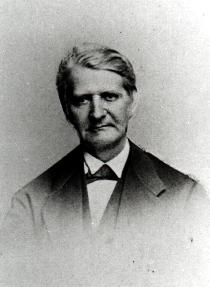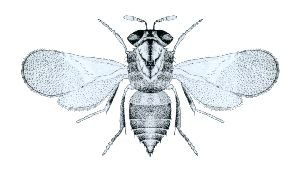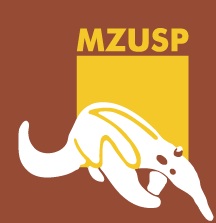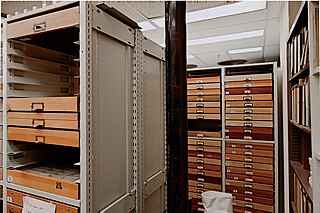
The University of California, Riverside is a public land-grant research university in Riverside, California. It is one of the ten campuses of the University of California system. The main campus sits on 1,900 acres (769 ha) in a suburban district of Riverside with a branch campus of 20 acres (8 ha) in Palm Desert. In 1907, the predecessor to UCR was founded as the UC Citrus Experiment Station, Riverside which pioneered research in biological pest control and the use of growth regulators.

Francis Walker was an English entomologist. He was born in Southgate, London, on 31 July 1809 and died at Wanstead, England on 5 October 1874. He was one of the most prolific authors in entomology, and stirred controversy during his later life as his publications resulted in a huge number of junior synonyms. However, his assiduous work on the collections of the British Museum had great significance.

Alexander Henry Haliday was an Irish entomologist. He is primarily known for his work on Hymenoptera, Diptera, and Thysanoptera, but worked on all insect orders and on many aspects of entomology.

Arnold Förster was a German entomologist, who worked mainly on Coleoptera and Hymenoptera.

The Mymaridae, commonly known as fairyflies or fairy wasps, are a family of chalcidoid wasps found in temperate and tropical regions throughout the world. The family contains around 100 genera with 1,400 species.

The Trichogrammatidae are a family of small endoparasitoid wasps in the superfamily Chalcidoidea that include some of the smallest of all insects, with most species having adults less than 1 mm in length, with species of Megaphragma having an adult body length less than 300 μm. Over 840 species are placed in about 80 genera; their distribution is worldwide.

The Aphelinidae are a moderate-sized family of tiny parasitic wasps, with about 1100 described species in some 28 genera. These minute insects are challenging to study, as they deteriorate rapidly after death unless extreme care is taken, making identification of most museum specimens difficult. The larvae of the majority are primary parasitoids on Hemiptera, though other hosts are attacked, and details of the life history can be variable. Males and females may have different hosts and different life histories.

The Tetracampidae are a small family of parasitic wasps in the superfamily Chalcidoidea. They are parasitoids of phytophagous insects, primarily flies. The 44 species in 15 genera are almost entirely absent from the New World.
Philip Hunter Timberlake (1883-1981) was one of the most prolific American entomologists of the 20th century. He was born on June 5, 1883, in Bethel, Maine, and died in 1981 in Riverside, California, where he had served as an Associate Entomologist in the Department of Entomology of the University of California, Riverside.
The University of California Citrus Experiment Station is the founding unit of the University of California, Riverside campus in Riverside, California, United States. The station contributed greatly to the cultivation of the orange and the overall agriculture industry in California. Established February 14, 1907, the station celebrated its 100th anniversary in 2007.

The UCR Citrus Variety Collection (CVC) is one of the most important collections of citrus diversity in the world. It is used for research, plant breeding, and educational extension activities on the UC Riverside campus in Riverside, California.

Centuria Insectorum is a 1763 taxonomic work by Carl Linnaeus, and defended as a thesis by Boas Johansson; which of the two men should for taxonomic purposes be credited with its authorship has been the subject of some controversy. It includes descriptions of 102 new insect and crustacean species that had been sent to Linnaeus from British America, Suriname, Java and other locations. Most of the new names included in Centuria Insectorum are still in use, although a few have been sunk into synonymy, and one was the result of a hoax: a common brimstone butterfly with spots painted on was described as the new "species" Papilio ecclipsis.

A zoological specimen is an animal or part of an animal preserved for scientific use. Various uses are: to verify the identity of a (species), to allow study, increase public knowledge of zoology. Zoological specimens are extremely diverse. Examples are bird and mammal study skins, mounted specimens, skeletal material, casts, pinned insects, dried material, animals preserved in liquid preservatives, and microscope slides. Natural history museums are repositories of zoological specimens

The Bohart Museum of Entomology was founded in 1946 on the campus of the University of California, Davis. The museum is currently the seventh largest insect collection in North America with more than seven million specimens of terrestrial and freshwater arthropods. At least 90% of these holdings are insects. The collection is worldwide in scope with the Western Hemisphere, Indonesia, and Australasia particularly well represented.
Richard Mitchell Bohart was an American entomologist, university professor, and a member of the University of California, Davis Department of Entomology for more than 50 years. He taught courses in general entomology, insect systematics, and summer field courses in insect identification. From 1963 to 1967 he served as chair of the Department of Entomology for the University of California at Davis.

The Museum of Zoology of the University of São Paulo is a public natural history museum located in the historic Ipiranga district of São Paulo, Brazil. The MZUSP is an educational and research institution that is part of the University of São Paulo. The museum began at the end of the 19th century as part of the Museu Paulista; in 1941, it moved into a dedicated building. In 1969 the museum became a part of the University of São Paulo, receiving its current name.

The Essig Museum of Entomology is a research museum dedicated to terrestrial arthropods, located at the University of California at Berkeley. It contains perhaps the world's largest collection of California insects and has been ranked among the top university-based collections in North America. The museum is open to the public twice per year.
John Stuart Noyes is a Welsh entomologist.
Karl-Johan Hedqvist was a Swedish entomologist who focused on wasps (Hymenoptera), especially chalcid wasps and other parasitoid wasps. He described 260 species and over 70 genera of wasps.

The Lincoln University Entomology Research Collection is a collection of approximately 500,000 insect, spider, and other arthropod specimens housed in Lincoln University, New Zealand. Being one of New Zealand's largest insect research collections, it is the only one based in a university.















